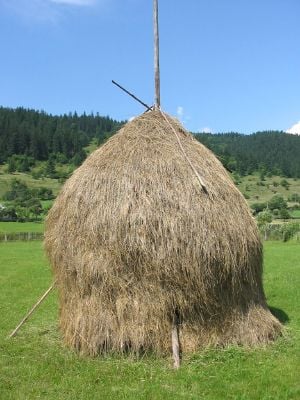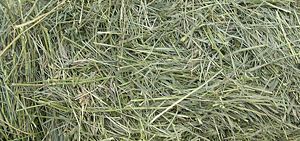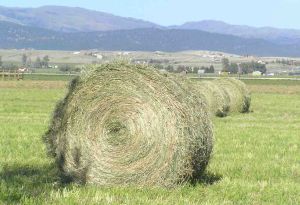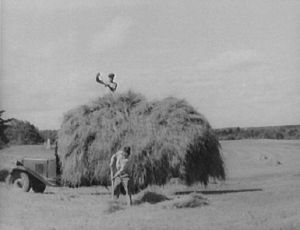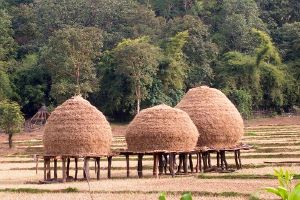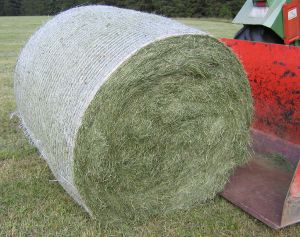Difference between revisions of "Hay" - New World Encyclopedia
(imported, credited, and categorized) |
(ready, images currently on article are ok) |
||
| Line 1: | Line 1: | ||
| + | {{ready}}{{images OK}} | ||
| + | |||
[[Image:Romanian hay.jpg|thumb|Stacked hay in Romania]] | [[Image:Romanian hay.jpg|thumb|Stacked hay in Romania]] | ||
[[Image:GrassHay1.jpg|thumb|300px|Close view of grass hay]] | [[Image:GrassHay1.jpg|thumb|300px|Close view of grass hay]] | ||
| Line 16: | Line 18: | ||
Hay is very sensitive to weather conditions, particularly when it is harvested. In drought conditions, both seed and leaf production are stunted, making hay that has a high ratio of dry coarse stems that have very low nutritional values. If the weather is too wet, the cut hay may spoil in the field before it can be baled. Or the hay may develop rot and mold after being baled, creating the potential for toxins to form in the feed, which could make the animals sick. It also has to be stored in a manner to prevent it from getting wet. Mold and spoilage reduce nutritional value and may cause illness in animals. | Hay is very sensitive to weather conditions, particularly when it is harvested. In drought conditions, both seed and leaf production are stunted, making hay that has a high ratio of dry coarse stems that have very low nutritional values. If the weather is too wet, the cut hay may spoil in the field before it can be baled. Or the hay may develop rot and mold after being baled, creating the potential for toxins to form in the feed, which could make the animals sick. It also has to be stored in a manner to prevent it from getting wet. Mold and spoilage reduce nutritional value and may cause illness in animals. | ||
| − | The successful harvest of maximum yields of high-quality hay is entirely dependent on the co-incident occurrence of optimum crop, field, and weather conditions. When this occurs, there may be a period of intense activity on the hay farm while harvest proceeds until weather conditions become | + | The successful harvest of maximum yields of high-quality hay is entirely dependent on the co-incident occurrence of optimum crop, field, and weather conditions. When this occurs, there may be a period of intense activity on the hay farm while harvest proceeds until weather conditions become unfavorable. The "summer vacation" period when public schools would close was by tradition to enable farm children to assist in the family hay harvest, as well as the harvest of other crops. This tradition is entrenched to the present day, even though only a very small fraction of school-aged children today in developed countries live on livestock farms. |
==Feeding hay== | ==Feeding hay== | ||
| Line 29: | Line 31: | ||
Different animals also utilize hay in different ways: Cattle evolved to eat forage in relatively large quantities at a single feeding, and then, due to the process of [[ruminant|rumination]], take a considerable amount of time for their stomachs to digest food, often accomplished while the animal is lying down, at rest. Thus quantity of hay is important for cattle, who are able to effectively digest hay of low quality if fed in sufficient amounts. <!--hope that is accurate, fix if it isn't—><!-- someone also please add how much hay cattle or sheep can eat in a day (i.e. compared to how horses can consume 2.5% of their weight per day)—> | Different animals also utilize hay in different ways: Cattle evolved to eat forage in relatively large quantities at a single feeding, and then, due to the process of [[ruminant|rumination]], take a considerable amount of time for their stomachs to digest food, often accomplished while the animal is lying down, at rest. Thus quantity of hay is important for cattle, who are able to effectively digest hay of low quality if fed in sufficient amounts. <!--hope that is accurate, fix if it isn't—><!-- someone also please add how much hay cattle or sheep can eat in a day (i.e. compared to how horses can consume 2.5% of their weight per day)—> | ||
| − | Conversely, horses digest food in small portions throughout the day, can only utilize approximately 2.5 percent of their body weight in feed in any 24 hour period, evolved to be continuously on the move while grazing, (covering up to 50 miles per day in the wild) and their stomach digests food quite rapidly. Thus they extract more nutrition out of smaller quantities of feed.<ref>Budiansky, Stephen. ''The Nature of Horses.'' Free Press | + | Conversely, horses digest food in small portions throughout the day, can only utilize approximately 2.5 percent of their body weight in feed in any 24 hour period, evolved to be continuously on the move while grazing, (covering up to 50 miles per day in the wild) and their stomach digests food quite rapidly. Thus they extract more nutrition out of smaller quantities of feed.<ref>Budiansky, Stephen. ''The Nature of Horses.'' New York : Free Press 1997. ISBN 0-684-82768-9</ref> However, when horses are fed low-quality hay, they may develop an unhealthy, obese, "hay belly" due to over-consumption of "empty" calories. If their type of feed is changed dramatically, or if they are fed moldy hay or hay containing toxic plants, they can become ill; [[horse colic|colic]] is the leading cause of death in horses. |
==Making and transporting hay== | ==Making and transporting hay== | ||
[[Image:Round hay bailer.jpg|thumb|left|A round baler baling hay]] | [[Image:Round hay bailer.jpg|thumb|left|A round baler baling hay]] | ||
| − | Hay production and harvest, colloquially known as "making hay" | + | Hay production and harvest, colloquially known as "making hay," "haymaking," or "doing hay," involves a multiple step process: cutting, drying or "curing," processing, and storing. Hayfields do not have to be reseeded each year in the way that [[grain]] crops are, but regular fertilizing is usually desirable, and overseeding a field every few years helps increase yield. |
Methods and the terminology to describe the steps of making hay has varied greatly throughout history, and many regional variations still exist today. However, whether done by hand or by modern mechanized equipment, tall grass and legumes at the proper stage of maturity must be cut, then allowed to dry (preferably by the sun), then raked into long, narrow piles known as [[windrow]]s. Next the cured hay is gathered up in some form (usually by some type of baling process) and placed for storage into a haystack or into a [[barn]] or shed to protect it from moisture and rot. | Methods and the terminology to describe the steps of making hay has varied greatly throughout history, and many regional variations still exist today. However, whether done by hand or by modern mechanized equipment, tall grass and legumes at the proper stage of maturity must be cut, then allowed to dry (preferably by the sun), then raked into long, narrow piles known as [[windrow]]s. Next the cured hay is gathered up in some form (usually by some type of baling process) and placed for storage into a haystack or into a [[barn]] or shed to protect it from moisture and rot. | ||
| Line 40: | Line 42: | ||
[[Image:Haying.jpg|thumb|Two men loading hay on a truck, Massachusetts, 1936]] | [[Image:Haying.jpg|thumb|Two men loading hay on a truck, Massachusetts, 1936]] | ||
| − | Hay can be raked into rows as it is cut, then turned periodically to dry, particularly if a modern [[swather]] is used. Or, especially with older equipment or methods, the hay is cut and allowed to lie spread out in the field until it is dry, then raked into rows for processing into bales afterwards. During the drying period, which can take several days, the process can be speeded up by turning the cut hay over with a [[hay rake]] or spreading it out a [[tedder (machine)|tedder]]. If it rains while the hay is drying, turning the windrow can also allow it to dry faster. However, turning the hay too often or too roughly can also cause drying leaf matter to fall off, reducing the nutrients available to animals. Drying can also be speeded up by mechanized processes, such as use of a [[Conditioner (farming)|hay conditioner]], or by use of chemicals sprayed onto the hay to speed [[evaporation]] of moisture, though these are more expensive techniques, not in general use except in areas where there is a combination of modern technology, high prices for hay, and too much rain for hay to dry properly.<ref>[http://www.uwex.edu/ces/forage/wfc/proceedings2003/equipment.htm | + | Hay can be raked into rows as it is cut, then turned periodically to dry, particularly if a modern [[swather]] is used. Or, especially with older equipment or methods, the hay is cut and allowed to lie spread out in the field until it is dry, then raked into rows for processing into bales afterwards. During the drying period, which can take several days, the process can be speeded up by turning the cut hay over with a [[hay rake]] or spreading it out a [[tedder (machine)|tedder]]. If it rains while the hay is drying, turning the windrow can also allow it to dry faster. However, turning the hay too often or too roughly can also cause drying leaf matter to fall off, reducing the nutrients available to animals. Drying can also be speeded up by mechanized processes, such as use of a [[Conditioner (farming)|hay conditioner]], or by use of chemicals sprayed onto the hay to speed [[evaporation]] of moisture, though these are more expensive techniques, not in general use except in areas where there is a combination of modern technology, high prices for hay, and too much rain for hay to dry properly.<ref>[http://www.uwex.edu/ces/forage/wfc/proceedings2003/equipment.htm Equipment to rake and merge hay and forage] - Retrieved October 3, 2007.</ref> |
Once hay is cut, dried and raked into windrows, it is usually gathered into bales or bundles, then hauled to a central location for storage. In some places, depending on geography, region, climate, and culture, hay is gathered loose and stacked without being baled first. | Once hay is cut, dried and raked into windrows, it is usually gathered into bales or bundles, then hauled to a central location for storage. In some places, depending on geography, region, climate, and culture, hay is gathered loose and stacked without being baled first. | ||
| Line 56: | Line 58: | ||
After hay was cut and had dried, the hay was raked or "rowed up" by raking it into a linear heap by hand or with a horse-drawn implement. | After hay was cut and had dried, the hay was raked or "rowed up" by raking it into a linear heap by hand or with a horse-drawn implement. | ||
| − | Turning hay, when needed, originally was done by hand with a fork or rake. Once the dried hay was rowed up, it was gathered into a type of [[wagon]] called a hay rack (or "hay rick"). In early days, this was done by forking it into a horsedrawn [[cart]] or [[dray]] or onto a [[truck]], later by a [[hay sweep|sweep]] attached to a | + | Turning hay, when needed, originally was done by hand with a fork or rake. Once the dried hay was rowed up, it was gathered into a type of [[wagon]] called a hay rack (or "hay rick"). In early days, this was done by forking it into a horsedrawn [[cart]] or [[dray]] or onto a [[truck]], later by a [[hay sweep|sweep]] attached to a truck or [[tractor]]. Alternatively, the loose hay could be put into [[stook]]s or shocks before being collected. |
Loose hay was taken to an area designated for storage—usually a slightly raised area for drainage—and built into a hay stack. The stack was made waterproof as it was built (a task of considerable skill) and the hay would compress under its own weight and cure by the release of heat from the residual moisture in the hay and from the compression forces. The stack was fenced from the rest of the paddock. When needed the haystack would be cut open, using a hay-knife, and some would be fed out to animals each day. | Loose hay was taken to an area designated for storage—usually a slightly raised area for drainage—and built into a hay stack. The stack was made waterproof as it was built (a task of considerable skill) and the hay would compress under its own weight and cure by the release of heat from the residual moisture in the hay and from the compression forces. The stack was fenced from the rest of the paddock. When needed the haystack would be cut open, using a hay-knife, and some would be fed out to animals each day. | ||
| Line 68: | Line 70: | ||
Modern mechanized hay production today is usually performed by a number of machines. While small operations use a [[tractor]] to pull various implements for mowing and raking, larger operations use specialized machines such as a [[mower]] or a [[swather]], which are designed to cut the hay and arrange it into a windrow in one step. [[Baler]]s are usually pulled by a tractor, with larger balers requiring more powerful tractors. | Modern mechanized hay production today is usually performed by a number of machines. While small operations use a [[tractor]] to pull various implements for mowing and raking, larger operations use specialized machines such as a [[mower]] or a [[swather]], which are designed to cut the hay and arrange it into a windrow in one step. [[Baler]]s are usually pulled by a tractor, with larger balers requiring more powerful tractors. | ||
| − | Mobile [[baler]]s, machines which gather and bale hay in one process, were first developed around 1940. The first balers produced rectangular bales small enough for a person to lift, usually between 70 and 100 pounds each. The size and shape made it possible for people to pick bales up, stack them on a vehicle for transport to a storage area, then build a haystack by hand. However, to save labor and increase safety, loaders and stackers were also developed to mechanise the transport of small bales from the field to the haystack. Later, balers were developed capable of producing large bales that weigh up to 3000 pounds.<ref> | + | Mobile [[baler]]s, machines which gather and bale hay in one process, were first developed around 1940. The first balers produced rectangular bales small enough for a person to lift, usually between 70 and 100 pounds each. The size and shape made it possible for people to pick bales up, stack them on a vehicle for transport to a storage area, then build a haystack by hand. However, to save labor and increase safety, loaders and stackers were also developed to mechanise the transport of small bales from the field to the haystack. Later, balers were developed capable of producing large bales that weigh up to 3000 pounds.<ref>[http://extension.missouri.edu/explore/agguides/agengin/g01955.htm Large Round Bales: Management] - Retrieved October 3, 2007.</ref> |
===Small bales=== | ===Small bales=== | ||
| Line 76: | Line 78: | ||
Small bales are stacked in a criss-crossed fashion sometimes called a "rick" or "hayrick." Since rain washes nutrition out of the hay and can cause spoilage or mold, hay in small bales is often stored in a hayshed or protected by [[tarpaulin]]s. If this is not done, the top two layers of the stack are often lost to rot and mold, and if the stack is not arranged in a proper hayrick, moisture can seep even deeper into the stack. | Small bales are stacked in a criss-crossed fashion sometimes called a "rick" or "hayrick." Since rain washes nutrition out of the hay and can cause spoilage or mold, hay in small bales is often stored in a hayshed or protected by [[tarpaulin]]s. If this is not done, the top two layers of the stack are often lost to rot and mold, and if the stack is not arranged in a proper hayrick, moisture can seep even deeper into the stack. | ||
| − | People who own small numbers of livestock, particularly [[horse]]s, still prefer small bales that can be handled by one person without machinery. There is also a risk that hay baled while still too damp can produce mold inside the bale, or decaying carcasses of small creatures that were accidentally killed by baling equipment and swept up into the bales can produce toxins such as [[botulism]]. Both can be deadly to non-[[ruminant]] herbivores, such as | + | People who own small numbers of livestock, particularly [[horse]]s, still prefer small bales that can be handled by one person without machinery. There is also a risk that hay baled while still too damp can produce mold inside the bale, or decaying carcasses of small creatures that were accidentally killed by baling equipment and swept up into the bales can produce toxins such as [[botulism]]. Both can be deadly to non-[[ruminant]] herbivores, such as horses, and when this occurs, the entire contaminated bale should be thrown out, another reason some livestock owners continue to support the market for small bales. |
===Large bales=== | ===Large bales=== | ||
| Line 82: | Line 84: | ||
Many farmers, particularly those who feed large herds, have moved to balers which produce much larger bales, maximizing the amount of hay which is protected from the elements. Large bales come in two types, round and square. "Large Square" bales, which can weigh up to 1000kg (2,200 lbs), can be stacked and are easier to transport on trucks. Round bales, which are typically weigh 300-400kg (700-900 lbs), are more moisture-resistant, and pack the hay more densely (especially at the center). Round bales are quickly fed with the use of mechanized equipment. | Many farmers, particularly those who feed large herds, have moved to balers which produce much larger bales, maximizing the amount of hay which is protected from the elements. Large bales come in two types, round and square. "Large Square" bales, which can weigh up to 1000kg (2,200 lbs), can be stacked and are easier to transport on trucks. Round bales, which are typically weigh 300-400kg (700-900 lbs), are more moisture-resistant, and pack the hay more densely (especially at the center). Round bales are quickly fed with the use of mechanized equipment. | ||
| − | The ratio of volume to surface area makes it possible for many dry-area farmers to leave large bales outside until they are consumed. Wet-area farmers and those in climates with heavy snowfall either stack round bales under a shed or tarp, but have also developed a light but durable plastic wrap that partially encloses bales left outside. The wrap repels moisture, but leaves the ends of the bale exposed so that the hay itselt can "breathe" and does not begin to ferment. However, when possible to store round bales under a shed, they last longer and less hay is lost to rot and moisture.<ref> | + | The ratio of volume to surface area makes it possible for many dry-area farmers to leave large bales outside until they are consumed. Wet-area farmers and those in climates with heavy snowfall either stack round bales under a shed or tarp, but have also developed a light but durable plastic wrap that partially encloses bales left outside. The wrap repels moisture, but leaves the ends of the bale exposed so that the hay itselt can "breathe" and does not begin to ferment. However, when possible to store round bales under a shed, they last longer and less hay is lost to rot and moisture.<ref>[http://www.caf.wvu.edu/~forage/roundbale.htm Round Bale Storage Costs] - Retrieved October 3, 2007.</ref> |
[[Image:Heuballen Plastik Steiermark.jpg|left|thumb|A completely wrapped [[silage]] bale in [[Germany]].]] | [[Image:Heuballen Plastik Steiermark.jpg|left|thumb|A completely wrapped [[silage]] bale in [[Germany]].]] | ||
| − | For animals that eat [[silage]], a [[Bale wrapper]] may be used to seal a round bale completely and trigger the fermentation process. It is a technique used as a money-saving process by producers who do not have access to a [[silo]], and for producing silage that is transported to other locations. However, a | + | For animals that eat [[silage]], a [[Bale wrapper]] may be used to seal a round bale completely and trigger the fermentation process. It is a technique used as a money-saving process by producers who do not have access to a [[silo]], and for producing silage that is transported to other locations. However, a silo is still a preferred method for making silage.<ref>[http://cropsoil.psu.edu/extension/facts/agfact9.pdf Large Round Bale Silage] - Retrieved October 3, 2007.</ref> In very damp climates, it is a legitimate alternative to drying hay completely and when processed properly, the natural fermentation process prevents mold and rot. Round bale silage is also sometimes called "haylage," and is seen more commonly in [[Europe]] than in either the [[USA]] or [[Australia]]. However, hay stored in this fashion must remain completely sealed in plastic, as any holes or tears can stop the preservation properties of fermentation and lead to spoilage.<ref>[http://www.ces.ncsu.edu/onslow/AG/hay/haylage.html Haylage] - Retrieved October 3, 2007.</ref> |
==Safety issues== | ==Safety issues== | ||
| − | Haystacks produce internal heat due to bacterial fermentation. If the hay was baled from moist grass, the heat produced can be enough to set the haystack on fire. Even today, [[farmer]]s have to be careful about moisture levels to avoid this "spontaneous combustion" | + | Haystacks produce internal heat due to bacterial fermentation. If the hay was baled from moist grass, the heat produced can be enough to set the haystack on fire. Even today, [[farmer]]s have to be careful about moisture levels to avoid this "spontaneous combustion," because haystack fires can be very dangerous.<ref>[http://www.montana.edu/wwwpb/ag/hayfire.html Haystack Fire] - Retrieved October 3, 2007.</ref> |
| − | Due to its weight, hay in general can cause a number of injuries to humans related to lifting and throwing bales, as well as risks related to stacking and storing, such as the danger of having a poorly-constructed stack collapse, causing either falls to people on the stack or injuries to people on the ground who are struck by falling bales. Large round hay bales present a particular danger to those who handle them because they can weigh over a thousand pounds and cannot be moved without specialized equipment. Nonetheless, because they are cylindrical in shape, and thus can roll easily, it is not uncommon for them to fall from stacks or roll off from equipment used to handle them. From 1992 to 1998, 74 farm workers in the [[United States]] were killed in large round hay bale accidents, usually when bales were being moved from one location to another, such as when feeding livestock. <ref name="danger"> | + | Due to its weight, hay in general can cause a number of injuries to humans related to lifting and throwing bales, as well as risks related to stacking and storing, such as the danger of having a poorly-constructed stack collapse, causing either falls to people on the stack or injuries to people on the ground who are struck by falling bales. Large round hay bales present a particular danger to those who handle them because they can weigh over a thousand pounds and cannot be moved without specialized equipment. Nonetheless, because they are cylindrical in shape, and thus can roll easily, it is not uncommon for them to fall from stacks or roll off from equipment used to handle them. From 1992 to 1998, 74 farm workers in the [[United States]] were killed in large round hay bale accidents, usually when bales were being moved from one location to another, such as when feeding livestock. <ref name="danger">[http://www.cdc.gov/niosh/hid13.html Hazards Associated with Using Farm Tractors to Move Large Bales] - Retrieved October 3, 2007.</ref><ref name="Minnesota">[http://jama.ama-assn.org/cgi/content/full/279/9/647 JAMA - Fatalities Associated With Large Round Hay Bales—Minnesota, 1994-1996] - Retrieved October 3, 2007.</ref>. |
| − | Hay is generally one of the safest feeds to provide to [[domesticated]] grazing [[herbivore]]s. However, some precautions are needed. Amount must be monitored so that animals do not get too fat or too thin. Supplemental feed may be required for [[working animal]]s with high energy requirements. Animals who eat spoiled hay may develop a variety of illnesses, from coughs related to dust and [[mold]], to various other illnesses, the most serious of which may be [[botulism]], which can occur if a small animal, such as a rodent or snake, is killed by the baling equipment then rots inside the bale, causing a toxin to form. Some animals are sensitive to particular [[fungi]] or molds that may grow on living plants. For example, an [[endophytic]] [[fungus]] that sometimes grows on [[fescue]] can cause [[abortion]] in pregnant [[mare (horse)|mares]].<ref> | + | Hay is generally one of the safest feeds to provide to [[domesticated]] grazing [[herbivore]]s. However, some precautions are needed. Amount must be monitored so that animals do not get too fat or too thin. Supplemental feed may be required for [[working animal]]s with high energy requirements. Animals who eat spoiled hay may develop a variety of illnesses, from coughs related to dust and [[mold]], to various other illnesses, the most serious of which may be [[botulism]], which can occur if a small animal, such as a rodent or snake, is killed by the baling equipment then rots inside the bale, causing a toxin to form. Some animals are sensitive to particular [[fungi]] or molds that may grow on living plants. For example, an [[endophytic]] [[fungus]] that sometimes grows on [[fescue]] can cause [[abortion]] in pregnant [[mare (horse)|mares]].<ref>[http://www.omafra.gov.on.ca/english/livestock/horses/facts/05-061.htm Abortion in Horses] - Retrieved October 3, 2007.</ref> Some plants themselves may also be toxic to some animals. For example, [[Pimelea]], a native Australian plant, also known as flax weed, is highly toxic to cattle.<ref>[http://www.abc.net.au/rural/qld/content/2006/s1582357.htm Toxic Weed Kills Cattle] - Retrieved October 3, 2007.</ref> |
[[Image:Hayfield2.jpg|600px|center|thumb|Field of freshly baled round hay bales. Lines in field are tracks left from the baler]] | [[Image:Hayfield2.jpg|600px|center|thumb|Field of freshly baled round hay bales. Lines in field are tracks left from the baler]] | ||
| Line 111: | Line 113: | ||
*[[Export Hay]] | *[[Export Hay]] | ||
| − | == | + | ==Notes== |
{{reflist}} | {{reflist}} | ||
==External links== | ==External links== | ||
| − | *[http://www.liverpoolmuseums.org.uk/picture-of-month/displaypicture.asp?venue=7&id=95 'Haymakers' and 'Haycarting' by George Stubbs] | + | *[http://www.liverpoolmuseums.org.uk/picture-of-month/displaypicture.asp?venue=7&id=95 'Haymakers' and 'Haycarting' by George Stubbs] - Retrieved October 3, 2007. |
| − | *[http://www.pukeariki.com/mi/stories/inventions/loubutler.asp Lou Butler's patented sweep was used everywhere] | + | *[http://www.pukeariki.com/mi/stories/inventions/loubutler.asp Lou Butler's patented sweep was used everywhere] - Retrieved October 3, 2007. |
| − | *[http://www.agriculturemuseum.org/ New Jersey Museum of Agriculture], | + | *[http://www.agriculturemuseum.org/ New Jersey Museum of Agriculture] - Retrieved October 3, 2007. |
[[Category:Life sciences]] | [[Category:Life sciences]] | ||
{{Credits|161490255}} | {{Credits|161490255}} | ||
Revision as of 01:47, 3 October 2007
Hay is dried grass or legumes cut, stored, and used for animal feed, particularly for grazing animals like cattle, horses, goats and sheep. Small pets such as guinea pigs and rabbits also enjoy hay, though they only eat very small quantities. Pigs may be fed hay, but they do not digest plant fiber very efficiently.
Hay is fed when or where there is not enough pasture or rangeland on which to graze an animal, when grazing is unavailable due to weather - such as during the winter, or when lush pasture by itself is too rich for easy digestion by the animal. It is also fed during times when an animal is unable to access pasture, such as when animals are kept in a stable or barn.
Contents of hay
Commonly used plants for hay include mixtures of grasses such as rye grass (Italian rye grass, Lolium multiflorum), timothy, brome, fescue, coastal bermuda, orchard grass, and other native species, depending on region. Many types of hay may also include legumes such as alfalfa (lucerne) and clovers (red, white and subterraneum). Pasture flowers are also sometimes a part of the mix, though other than legumes, which ideally are cut pre-bloom, flowers are not necessarily desired, and in some cases may be toxic to animals.
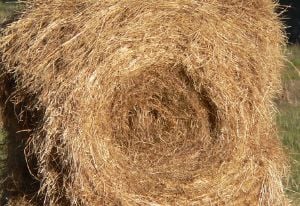
Oat, barley, and wheat plant materials are occasionally seen in hay products, though usually in the form of straw, a harvest byproduct where only the stems are dried and baled after the grain is harvested. Straw is used for animal bedding and generally is considered poor animal fodder, though sometimes it is used as a source of empty calories to give animals a feeling of fullness or satiety when on an otherwise restricted diet.
It is the leaf and seed material in the hay that determines its quality. Farmers try to harvest hay at the point when the seed heads are not quite ripe and the leaf is at its maximum when the grass is mowed in the field. The cut material is allowed to dry so that the bulk of the moisture is removed but the leafy material is still robust enough to be picked up from the ground by machinery and processed into storage in bales, stacks or pits.
Hay is very sensitive to weather conditions, particularly when it is harvested. In drought conditions, both seed and leaf production are stunted, making hay that has a high ratio of dry coarse stems that have very low nutritional values. If the weather is too wet, the cut hay may spoil in the field before it can be baled. Or the hay may develop rot and mold after being baled, creating the potential for toxins to form in the feed, which could make the animals sick. It also has to be stored in a manner to prevent it from getting wet. Mold and spoilage reduce nutritional value and may cause illness in animals.
The successful harvest of maximum yields of high-quality hay is entirely dependent on the co-incident occurrence of optimum crop, field, and weather conditions. When this occurs, there may be a period of intense activity on the hay farm while harvest proceeds until weather conditions become unfavorable. The "summer vacation" period when public schools would close was by tradition to enable farm children to assist in the family hay harvest, as well as the harvest of other crops. This tradition is entrenched to the present day, even though only a very small fraction of school-aged children today in developed countries live on livestock farms.
Feeding hay
Hay or grass is the foundation of the diet for all grazing animals and can provide as much as 100% of the fodder required for an animal. Hay is usually fed to an animal in place of allowing the animal to graze on grasses in a pasture. Animals that can eat hay vary in the types of grasses suitable for consumption, the ways they consume hay, and how they digest it. Therefore different types of animals require hay that consists of similar plants to what they would eat while grazing, and likewise, plants that are toxic to an animal in pasture are also toxic if they are dried into hay.
Most animals are fed hay in two daily feedings, morning and evening. However, this schedule is more for the convenience of humans, as most grazing animals on pasture naturally consume fodder in multiple feedings throughout the day. Some animals, especially those being raised for meat, may be given enough hay that they simply are able to eat all day. Other animals, especially those that are ridden or driven as working animals, are only free to eat when not working, and may be given a more limited amount of hay in order to prevent them from getting too fat. The proper amount of hay and the type of hay required varies somewhat between different species. Some animals are also fed concentrated feeds such as grain or vitamin supplements in addition to hay. However, in most cases , hay or other forage must make up at least 50% of the diet by weight.
One of the most significant differences in hay digestion is between ruminant animals, such as cattle; and non-ruminant, hindgut fermentors, such as horses. Both types of animals can digest cellulose in grass and hay, but do so by different mechanisms. Because of the four-chambered stomach of cattle, they are often able to break down older forage and have more tolerance of mold or dust. Conversely, the single-chambered stomach and cecum or "hindgut" of the horse is more sensitive to changes in feeds and the presence of toxins, requiring horses to be fed hay of more consistent quality.
Different animals also utilize hay in different ways: Cattle evolved to eat forage in relatively large quantities at a single feeding, and then, due to the process of rumination, take a considerable amount of time for their stomachs to digest food, often accomplished while the animal is lying down, at rest. Thus quantity of hay is important for cattle, who are able to effectively digest hay of low quality if fed in sufficient amounts.
Conversely, horses digest food in small portions throughout the day, can only utilize approximately 2.5 percent of their body weight in feed in any 24 hour period, evolved to be continuously on the move while grazing, (covering up to 50 miles per day in the wild) and their stomach digests food quite rapidly. Thus they extract more nutrition out of smaller quantities of feed.[1] However, when horses are fed low-quality hay, they may develop an unhealthy, obese, "hay belly" due to over-consumption of "empty" calories. If their type of feed is changed dramatically, or if they are fed moldy hay or hay containing toxic plants, they can become ill; colic is the leading cause of death in horses.
Making and transporting hay
Hay production and harvest, colloquially known as "making hay," "haymaking," or "doing hay," involves a multiple step process: cutting, drying or "curing," processing, and storing. Hayfields do not have to be reseeded each year in the way that grain crops are, but regular fertilizing is usually desirable, and overseeding a field every few years helps increase yield.
Methods and the terminology to describe the steps of making hay has varied greatly throughout history, and many regional variations still exist today. However, whether done by hand or by modern mechanized equipment, tall grass and legumes at the proper stage of maturity must be cut, then allowed to dry (preferably by the sun), then raked into long, narrow piles known as windrows. Next the cured hay is gathered up in some form (usually by some type of baling process) and placed for storage into a haystack or into a barn or shed to protect it from moisture and rot.
During the growing season, which is spring and early summer in temperate climates, grass grows at a fast pace. It is at its greatest nutritive value when all leaves are fully developed and seed or flower heads are just a bit short of full maturity. When growth is at a maximum in the pasture, if judged correctly, the pasture is cut. Hay cut too early will not cure as easily due to high moisture content, plus it will produce a lower yield per acre than longer, more mature grass. But hay cut too late is coarser, lower in resale value and has lost some of its nutrients. There is usually about a two-week "window" of time in which hay is at its ideal stage for harvesting.
Hay can be raked into rows as it is cut, then turned periodically to dry, particularly if a modern swather is used. Or, especially with older equipment or methods, the hay is cut and allowed to lie spread out in the field until it is dry, then raked into rows for processing into bales afterwards. During the drying period, which can take several days, the process can be speeded up by turning the cut hay over with a hay rake or spreading it out a tedder. If it rains while the hay is drying, turning the windrow can also allow it to dry faster. However, turning the hay too often or too roughly can also cause drying leaf matter to fall off, reducing the nutrients available to animals. Drying can also be speeded up by mechanized processes, such as use of a hay conditioner, or by use of chemicals sprayed onto the hay to speed evaporation of moisture, though these are more expensive techniques, not in general use except in areas where there is a combination of modern technology, high prices for hay, and too much rain for hay to dry properly.[2]
Once hay is cut, dried and raked into windrows, it is usually gathered into bales or bundles, then hauled to a central location for storage. In some places, depending on geography, region, climate, and culture, hay is gathered loose and stacked without being baled first.
Hay must be kept dry in storage or it will rot. Hay stored outside must be stacked in such a way that moisture contact is minimal. Some stacks are arranged in such a manner that the hay itself "sheds" water when it falls. Other methods of stacking use the first layers or bales of hay as a cover to protect the rest. To completely keep out moisture, outside haystacks can also be covered by tarps, and many round bales are partially wrapped in plastic as part of the baling process. Hay is also stored under a roof when resources permit. It is frequently placed inside sheds, or stacked inside of a barn. Care must be taken that hay stored inside is never exposed to any possible source of heat or flame, both dry hay and the dust it produces are highly flammable
Early methods
Early farmers noticed that growing fields produced more fodder in the spring than the animals could consume, and that cutting the grass in the summer, allowing it to dry and storing it for the winter provided their domesticated animals with better quality nutrition than simply allowing them to dig through snow in the winter to find dried grass. Therefore, some fields were "shut up" for hay.
Up to the end of the 19th century, grass and legumes were not often grown together because crops were rotated. By the 20th century, however, good forage management techniques demonstrated that highly productive pastures were a mix of grasses and legumes, so compromises were made when it was time to mow. Later still, some farmers grew crops, like straight alfalfa (lucerne), for special-purpose hay such as that fed to dairy cattle.
Much hay was originally cut by scythe by teams of workers and gathered up into sheaves by hand. It was placed into stooks or "shocks" in the field until it could be gathered up for storage. Later, haying would be done by horse-drawn implements such as mowers and binders. With the invention of agricultural machinery such as the tractor and the baler, most hay production became mechanized by the 1930s.
After hay was cut and had dried, the hay was raked or "rowed up" by raking it into a linear heap by hand or with a horse-drawn implement. Turning hay, when needed, originally was done by hand with a fork or rake. Once the dried hay was rowed up, it was gathered into a type of wagon called a hay rack (or "hay rick"). In early days, this was done by forking it into a horsedrawn cart or dray or onto a truck, later by a sweep attached to a truck or tractor. Alternatively, the loose hay could be put into stooks or shocks before being collected.
Loose hay was taken to an area designated for storage—usually a slightly raised area for drainage—and built into a hay stack. The stack was made waterproof as it was built (a task of considerable skill) and the hay would compress under its own weight and cure by the release of heat from the residual moisture in the hay and from the compression forces. The stack was fenced from the rest of the paddock. When needed the haystack would be cut open, using a hay-knife, and some would be fed out to animals each day.
On some farms the loose hay was stored in a shed or barn, normally in such a way that it would compress down and cure. Hay could be stored in the second floor of the barn above the animals or in a specially designed barn with little internal structure to allow more room for the hay.
Depending on region, the term hay rick could refer to the machine for cutting hay, the hay stack or the wagon used to collect the hay.
Modern mechanised techniques
Modern mechanized hay production today is usually performed by a number of machines. While small operations use a tractor to pull various implements for mowing and raking, larger operations use specialized machines such as a mower or a swather, which are designed to cut the hay and arrange it into a windrow in one step. Balers are usually pulled by a tractor, with larger balers requiring more powerful tractors.
Mobile balers, machines which gather and bale hay in one process, were first developed around 1940. The first balers produced rectangular bales small enough for a person to lift, usually between 70 and 100 pounds each. The size and shape made it possible for people to pick bales up, stack them on a vehicle for transport to a storage area, then build a haystack by hand. However, to save labor and increase safety, loaders and stackers were also developed to mechanise the transport of small bales from the field to the haystack. Later, balers were developed capable of producing large bales that weigh up to 3000 pounds.[3]
Small bales
Small bales are still produced today. While balers for small bales are still manufactured, as well as loaders and stackers, there are some farms that still use equipment manufactured over 50 years ago, kept in good repair. The small bale remains part of overall ranch lore and tradition with "hay bucking" competitions still held for fun at many rodeos and county fairs.
Small bales are stacked in a criss-crossed fashion sometimes called a "rick" or "hayrick." Since rain washes nutrition out of the hay and can cause spoilage or mold, hay in small bales is often stored in a hayshed or protected by tarpaulins. If this is not done, the top two layers of the stack are often lost to rot and mold, and if the stack is not arranged in a proper hayrick, moisture can seep even deeper into the stack.
People who own small numbers of livestock, particularly horses, still prefer small bales that can be handled by one person without machinery. There is also a risk that hay baled while still too damp can produce mold inside the bale, or decaying carcasses of small creatures that were accidentally killed by baling equipment and swept up into the bales can produce toxins such as botulism. Both can be deadly to non-ruminant herbivores, such as horses, and when this occurs, the entire contaminated bale should be thrown out, another reason some livestock owners continue to support the market for small bales.
Large bales
Many farmers, particularly those who feed large herds, have moved to balers which produce much larger bales, maximizing the amount of hay which is protected from the elements. Large bales come in two types, round and square. "Large Square" bales, which can weigh up to 1000kg (2,200 lbs), can be stacked and are easier to transport on trucks. Round bales, which are typically weigh 300-400kg (700-900 lbs), are more moisture-resistant, and pack the hay more densely (especially at the center). Round bales are quickly fed with the use of mechanized equipment.
The ratio of volume to surface area makes it possible for many dry-area farmers to leave large bales outside until they are consumed. Wet-area farmers and those in climates with heavy snowfall either stack round bales under a shed or tarp, but have also developed a light but durable plastic wrap that partially encloses bales left outside. The wrap repels moisture, but leaves the ends of the bale exposed so that the hay itselt can "breathe" and does not begin to ferment. However, when possible to store round bales under a shed, they last longer and less hay is lost to rot and moisture.[4]
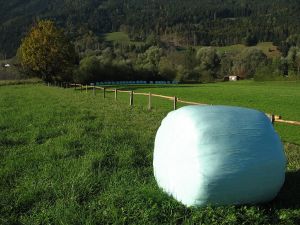
For animals that eat silage, a Bale wrapper may be used to seal a round bale completely and trigger the fermentation process. It is a technique used as a money-saving process by producers who do not have access to a silo, and for producing silage that is transported to other locations. However, a silo is still a preferred method for making silage.[5] In very damp climates, it is a legitimate alternative to drying hay completely and when processed properly, the natural fermentation process prevents mold and rot. Round bale silage is also sometimes called "haylage," and is seen more commonly in Europe than in either the USA or Australia. However, hay stored in this fashion must remain completely sealed in plastic, as any holes or tears can stop the preservation properties of fermentation and lead to spoilage.[6]
Safety issues
Haystacks produce internal heat due to bacterial fermentation. If the hay was baled from moist grass, the heat produced can be enough to set the haystack on fire. Even today, farmers have to be careful about moisture levels to avoid this "spontaneous combustion," because haystack fires can be very dangerous.[7]
Due to its weight, hay in general can cause a number of injuries to humans related to lifting and throwing bales, as well as risks related to stacking and storing, such as the danger of having a poorly-constructed stack collapse, causing either falls to people on the stack or injuries to people on the ground who are struck by falling bales. Large round hay bales present a particular danger to those who handle them because they can weigh over a thousand pounds and cannot be moved without specialized equipment. Nonetheless, because they are cylindrical in shape, and thus can roll easily, it is not uncommon for them to fall from stacks or roll off from equipment used to handle them. From 1992 to 1998, 74 farm workers in the United States were killed in large round hay bale accidents, usually when bales were being moved from one location to another, such as when feeding livestock. [8][9].
Hay is generally one of the safest feeds to provide to domesticated grazing herbivores. However, some precautions are needed. Amount must be monitored so that animals do not get too fat or too thin. Supplemental feed may be required for working animals with high energy requirements. Animals who eat spoiled hay may develop a variety of illnesses, from coughs related to dust and mold, to various other illnesses, the most serious of which may be botulism, which can occur if a small animal, such as a rodent or snake, is killed by the baling equipment then rots inside the bale, causing a toxin to form. Some animals are sensitive to particular fungi or molds that may grow on living plants. For example, an endophytic fungus that sometimes grows on fescue can cause abortion in pregnant mares.[10] Some plants themselves may also be toxic to some animals. For example, Pimelea, a native Australian plant, also known as flax weed, is highly toxic to cattle.[11]
See also
- fodder
- silage
- straw
- Swather
- Baler
- stover
- National Hay Association
- Hay buck
- pasture
- ranch
- Equine nutrition
- Export Hay
Notes
- ↑ Budiansky, Stephen. The Nature of Horses. New York : Free Press 1997. ISBN 0-684-82768-9
- ↑ Equipment to rake and merge hay and forage - Retrieved October 3, 2007.
- ↑ Large Round Bales: Management - Retrieved October 3, 2007.
- ↑ Round Bale Storage Costs - Retrieved October 3, 2007.
- ↑ Large Round Bale Silage - Retrieved October 3, 2007.
- ↑ Haylage - Retrieved October 3, 2007.
- ↑ Haystack Fire - Retrieved October 3, 2007.
- ↑ Hazards Associated with Using Farm Tractors to Move Large Bales - Retrieved October 3, 2007.
- ↑ JAMA - Fatalities Associated With Large Round Hay Bales—Minnesota, 1994-1996 - Retrieved October 3, 2007.
- ↑ Abortion in Horses - Retrieved October 3, 2007.
- ↑ Toxic Weed Kills Cattle - Retrieved October 3, 2007.
External links
- 'Haymakers' and 'Haycarting' by George Stubbs - Retrieved October 3, 2007.
- Lou Butler's patented sweep was used everywhere - Retrieved October 3, 2007.
- New Jersey Museum of Agriculture - Retrieved October 3, 2007.
Credits
New World Encyclopedia writers and editors rewrote and completed the Wikipedia article in accordance with New World Encyclopedia standards. This article abides by terms of the Creative Commons CC-by-sa 3.0 License (CC-by-sa), which may be used and disseminated with proper attribution. Credit is due under the terms of this license that can reference both the New World Encyclopedia contributors and the selfless volunteer contributors of the Wikimedia Foundation. To cite this article click here for a list of acceptable citing formats.The history of earlier contributions by wikipedians is accessible to researchers here:
The history of this article since it was imported to New World Encyclopedia:
Note: Some restrictions may apply to use of individual images which are separately licensed.
